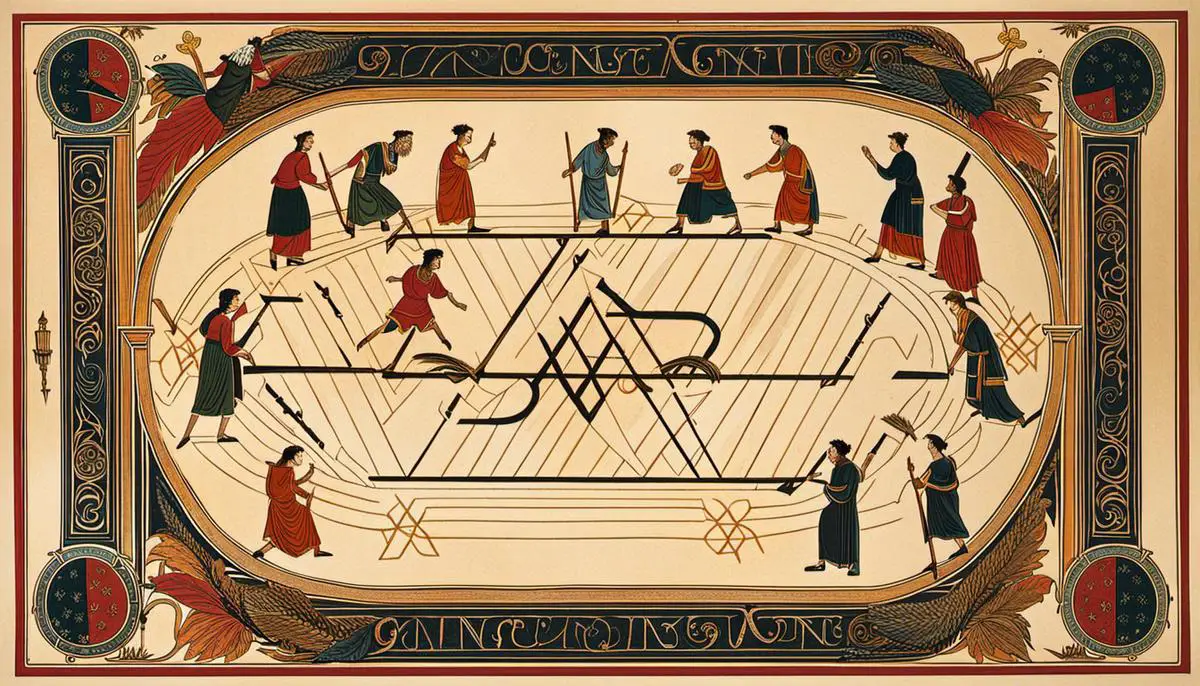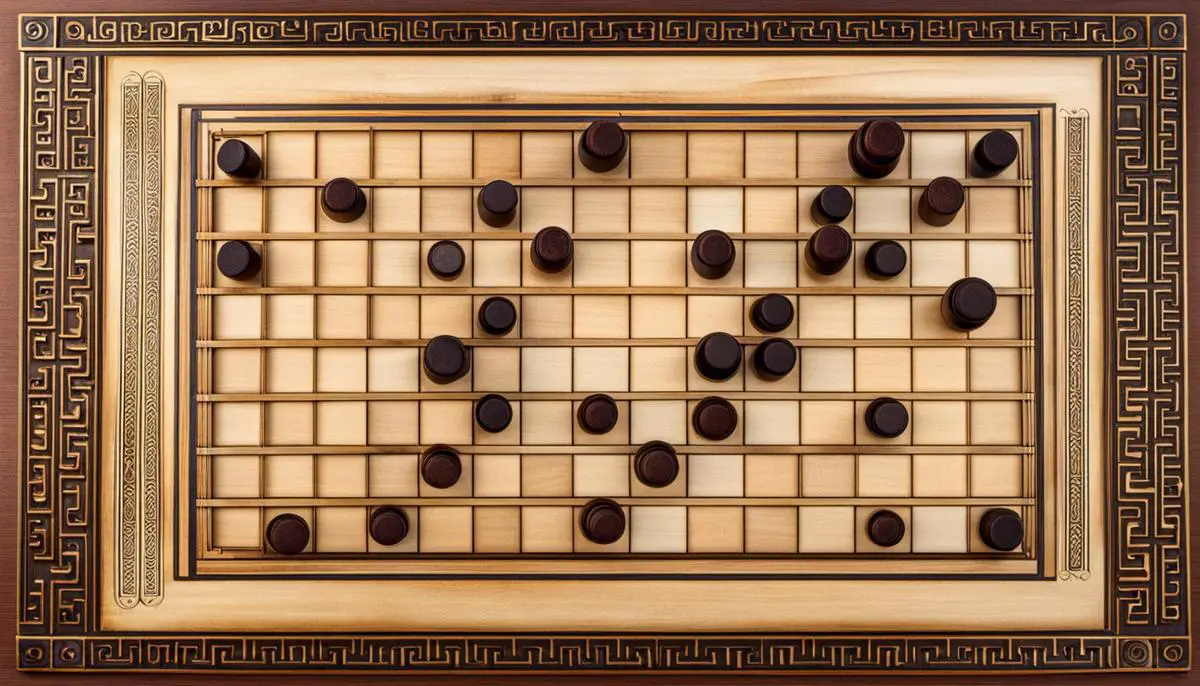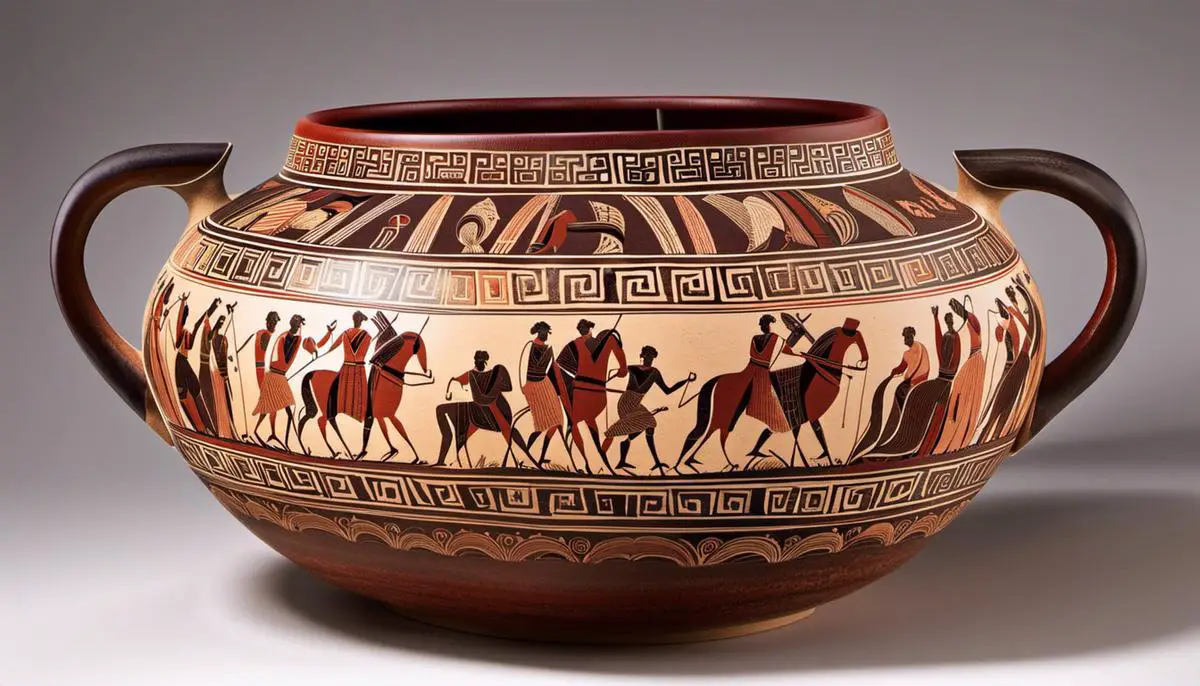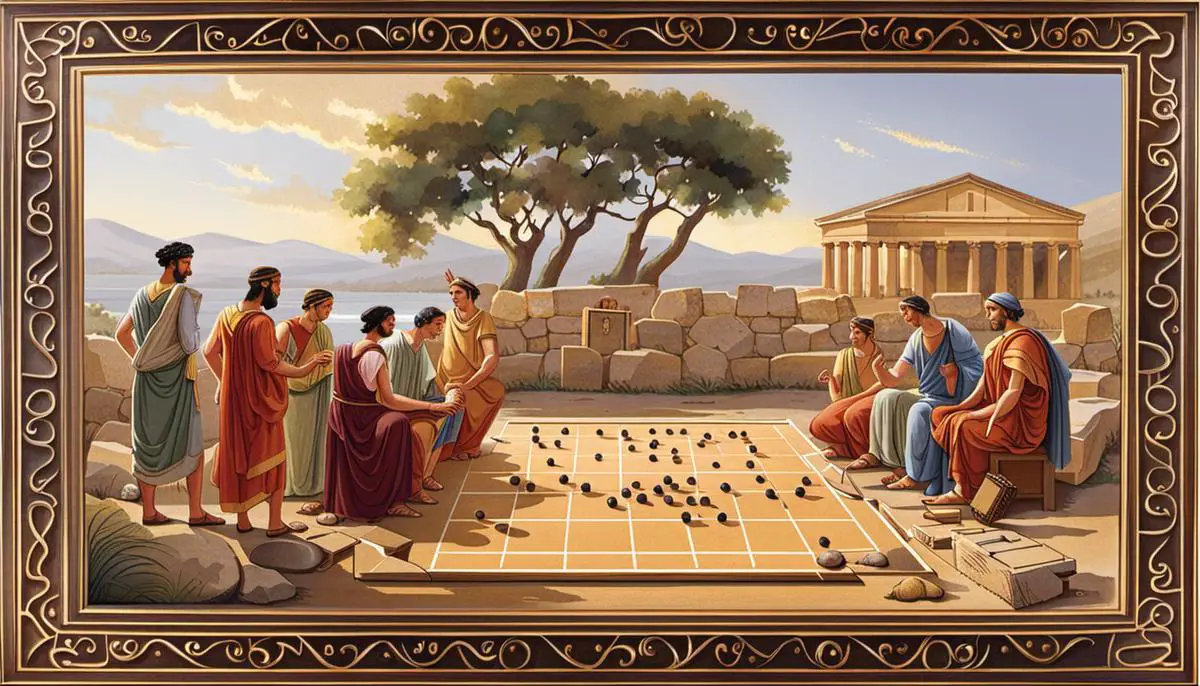The intriguing world of ancient Greek recreational activities uncovers a fascinating gem that has echoed through the ages – the game of Five Lines. Immersed profoundly in the annals of Greek history as well as mythology, this competitive pursuit formed a critical part of their societal norms, serving as more than merely an amusement. As we embark on this journey to understand and appreciate this time-honored game, we delve deeper into its origins, its rules, and the strategic nuances that it envelops. Furthermore, we explore the cultural impact that Five Lines has spurred, traversing the realms of literature, visual art, and its echoes in modern-day games.
History of the Five Lines Game
Historical Overview of the Five Lines Game
The Five Lines game, also known as “Pente Grammai,” holds a special place in the cultural heritage of Ancient Greece. This strategic contest was a viral phenomenon across Greek society, transcending the divides of age and status. From the scholarly circles of Athens to the trading ports of Corinth, the game captured imaginations and provided a common cultural connection.
Origins of the Game
Eye-catching frescoes and wall-reliefs reveal that the game’s inception lies deep within Greek history, dating back to an era well before the rebirth of the Olympic games in 776 BC. The five vertical lines used as the game’s board were engraved on public benches, squares, marketplaces, and other communal spaces, backed by the piercing of five holes into the ground. The exact origins remain shrouded in mystery, but historians postulate that the game could have possibly emerged during the Geometric period (900-700 BC).
Significance in Ancient Greek Society
The enchantment of the Five Lines game lies in its simplicity and its ability to foster social cohesion. Top-class philosophers, legendary warriors, and local tradesmen alike would enjoy the game, often surrounded by mesmerized onlookers. The game was not only a symbol of a shared culture but also an organic platform for cultivating social relationships. Often games would become tournaments, with passionate crowds betting on their favorite contenders.
Connection to Greek Mythology
The game of Five Lines carries an intrinsic connection to the labyrinthine tales of Greek mythology. Folklore credits Palamedes, a figure associated with keen intellect and strategic acumen, with the game’s creation. This attribution conjures up images of cunning heroes outmaneuvering their opponents in cerebral battles. Thus, the five lines game is imbued with a mythical aura, elevating it from being a mere pastime to representing the esteemed intellectual virtues revered in Greek society.
Understanding the Gameplay
The exact rules of the ancient game remain ambiguous, but scholars suggest it might have been similar to modern-day Tic Tac Toe or Three Men’s Morris. The game supposedly required two players who took turns placing their markers (pebbles, shells, etc.) on the five-pointed intersection of lines. The ultimate aim was to align three markers in a row before the opponent could.
The game of Five Lines, also known as Pentalitha, is more than just an archaic pastime from the historical records. It serves as a reflective lens to the societal, cultural, and intellectual norms of Ancient Greece. The communal gaming board around which it is centered is a symbol of the camaraderie, wit, and competitive spirit that marked this revered ancient civilization.

Rules and Gameplay
Unraveling the Mechanics of the Ancient Greek Five Lines Game
This strategic game, which traces its roots back to at least 400 B.C., combines physical agility with intellectual prowess for an engrossing play. The game of Five Lines or Pentalitha, as it is traditionally known, showcases the cleverness and strategic thinking that was prevalent among the ancient Greeks.
Playing Field Set-Up
The playing field for Five Lines resembles the pentagram shape, with five lines intersecting each other to create an interconnected series of ten points. These ten points are the potential positions or ‘houses’ that players aim to place their pieces or ‘men’. Each player starts with five men. The lines are either drawn in the sand or laid out with rope on a flat surface.
Setup and Scoring System
To begin, both players agree on a starting position for each of their five pieces. These positions must be at the intersections of the lines or the points of the pentagram. Each successful move onto an intersection earns one point. Points also can be scored by “jumping” a man over an another adjacent man to an empty spot on the other side, similar to in checkers. However, unlike in checkers, the jumped man is not removed from the playing field.
Rules of the Game
Several key rules govern the gameplay in Five Lines. The initial positioning of men cannot result in immediate scoring opportunities. The players take turns making moves, and each man can move along a line to an adjacent empty intersection point. This move to an adjacent intersection point must not pass over other men.
However, if a player’s man is adjacent to an opponent’s man and an empty intersection point is beyond the opponent’s man, the player can ‘jump’ the man to the empty point and gain one point. A multiple jump that passes over several men consecutively, called a ‘sweep’, earns the equivalent amount of points as men passed over.
The crucial rule in Five Lines is that jumps must be in straight lines. Players cannot change direction during a ‘sweep’. Players must make a jump if they can – it’s not optional.
The Objective of the Game
The goal of the game is to score more points than your opponent. A game of Five Lines ends when no more jumps can be made. If a player manages to achieve a full ‘sweep’ of five points in one move, it’s known as a ‘Pente’ and is highly esteemed.
Welcome to a comprehensive guide where you’ll find everything you need to know about the Ancient Greek game of Five Lines. To become proficient in this game, you’ll need a strategic mindset, an eye for opportunity, and the ability to anticipate several moves in advance.

Strategy and Techniques
Diving Deeper into the Game: The Ancient Greek Five Lines
The Five Lines, or shall we say Petteia, was extremely popular in ancient Greece, and revolved around a simple objective: trapping your opponent’s pieces between two of your own. Grasping this key strategy is essential for mastering the game. An interesting aspect to note is that unlike modern games like chess, every piece in Five Lines holds the same value and possesses the same movements.
Movements and Positions
All pieces move horizontally or vertically, like a rook in chess. However, unlike chess, the objective is not to capture the king but to put the opponent in a position where they cannot make a legal move. To achieve this, one can consider making moves that limit the opponent’s flexibility, but also ensure one’s own pieces aren’t left vulnerable. Understanding this is a fundamental step on your journey to improve your skills in Five Lines.
Strategic Planning and Techniques
Successful playing of the Five Lines game requires a blend of strategic foresight, tactical awareness, and careful positioning. Having an overview of the board enables you to make decisions about where to move your pieces not just on your next turn, but several turns ahead.
Strategic planning can be likened to the construction of a jigsaw puzzle, with early moves in less crowded areas of the board setting up for later in-game tactics. Experience will teach you to recognize game patterns, allowing you to predict the outcome of different strategies.
Focusing on Opponent
Understanding your opponent’s strategy is just as important. By being attentive to your opponent’s moves, you can anticipate their strategies, which is vital for winning. Keep in mind that an aggressive player might make a fatal mistake while pushing for a quick win, and a defensive player might leave an opening while trying to protect their pieces.
Practical Tips for Five Lines
To improve your Five Lines game, start slow and learn from each encounter. Practice against different types of opponents to understand varying strategies. Be flexible with your strategy and don’t be afraid to adapt your tactics based on your opponent’s gameplay.
Remember to control the center of the board, as this gives you more opportunities to attack and defend. Protect your pieces, but not at all costs. Brutal attacks often lead to mistakes, while excessive defense allows your opponent to corner you.
Mastering the Game of Five Lines
To develop proficiency in the Ancient Greek game of Five Lines, implementing patience, a well-thought strategy, and a good understanding of opponent’s moves are the critical factors. Having the ability to learn from game play and strategize accordingly will surely lead one to become skilled in this ancient game.

The Cultural Influence and Modern Adaptation
The Socio-Cultural Impact of Five Lines
The Five Lines, an venerated game from Ancient Greece also known as Pente Grammai, has left an indelible mark on Greek culture. The game was enjoyed across all strata of Greek society, ranging from commonplace citizens to noblemen and academics, highlighting its universal appeal. The exalted status of the game in society can be likened to the contemporary standing of chess, given its reliance on strategy and cognitive prowess.
Writings from that era often associate the game of Five Lines with intellectual pursuits and recreational activities. This cultural impact is reflected in Greek plays, historical scripts, and philosophical writings, offering extensive evidence of its cultural relevance and endurance. Greek visual arts too have embraced the game. It’s not uncommon to see depots of men immersed in Five Lines on classical Greek pottery. Surprisingly, several murals also portray mythological divinities such as Hermes playing the game, cementing its exalted position within Ancient Greek society.
Modern Adaptations and Rule Alterations
As for the modern adaptation of this ancient Greek game, Five lines, or its modern name Pente, was rediscovered and simplified in the late 20th century. Gary Gabrel revamped the game in 1977 and named it ‘Pente’, a game quite similar to the rules of Five Lines. It sparked a wave of enthusiasm at that time and was eventually mass-produced and marketed by Parker Brothers, ensuring its place in the pantheon of classic board games.
Pente goes beyond simply recreating the physical game; it revamps the rules based on a modern understanding of strategy and competition. The current game maintains the original goal of creating five stones in a row. Still, it has also introduced a new victory condition: capturing five pairs of your opponent’s stones. This addition has not only enhanced the intensity in competition but also diversified the strategies for winning, making the game more flexible and appealing to contemporary players.
More importantly, Pente is just one of the various adaptations of Five Lines. There is now a slew of other notable strategic board games derived from this ancient Greek game, such as Connect Five, Gomoku, and Renju, which have delighted Eastern and Western players alike for centuries, each with its unique rule set and strategic depths.
In summary, the Ancient Greek game of Five Lines has transpired through many cultures and centuries, an illustration of cultural trend transfusion into various cultures around the world. From captivating the minds of ancient Greeks to the hearts of modern board-game enthusiasts, the game has witnessed changes yet preserved the spirit of strategy and intellect.

Venturing through the millennia-old world of the Greek game of Five Lines, we have encountered its historical roots, delved into its layered gameplay rules, absorbed insights about strategic gameplay, and acknowledged its profound cultural influence. The essence of this game, distilled into modern adaptations and reflected in today’s recreational pursuits, attests to its timelessness. As Five Lines continues its rhythmic dance through generations, it remains an emblematic tribute to the ingenuity of ancient Grecian society, a testament to the love of strategy and competition that connects humanity across ages, and a perpetual reminder of how the past can shape, influence, and enrich our present.
Frequently Asked Questions: Five Lines Board Game
A: Five Lines is an ancient Greek board game played on a 5×5 grid. The goal is to form five stones in a row, either horizontally, vertically, or diagonally.
A: In Five Lines, players take turns placing stones on the board to create lines of five. They must strategize to block their opponent’s moves while seeking opportunities to create winning lines.
A: Five Lines is more complex than Tic-Tac-Toe and is not considered a solved game. Players need to think strategically and adapt their moves based on their opponent’s actions.
A: Yes, Five Lines holds historical significance as an ancient Greek board game, showcasing the entertainment and intellectual pursuits of ancient civilizations.
A: Yes, there are variations of Five Lines played on different board sizes, ranging from 5×5 to larger grids, offering varied challenges and gameplay experiences.
A: Yes, there are digital versions and online platforms where you can play Five Lines with friends or other players, preserving the tradition in a modern setting.
A: Five Lines develops strategic thinking, spatial awareness, and pattern recognition, making it an engaging and intellectually stimulating game.
A: The duration of Five Lines can vary based on players’ strategies and skill level. Generally, a game can last 10 to 20 minutes.
A: Five Lines is typically designed for two players, but adaptations can be made to accommodate larger groups, with players taking turns in a tournament-style format.
A: Five Lines shares similarities with other ancient board games like Go and Gomoku, emphasizing strategic placement of pieces and forming lines to win
